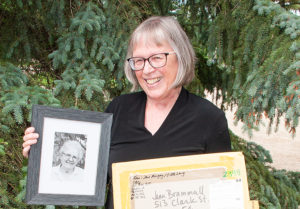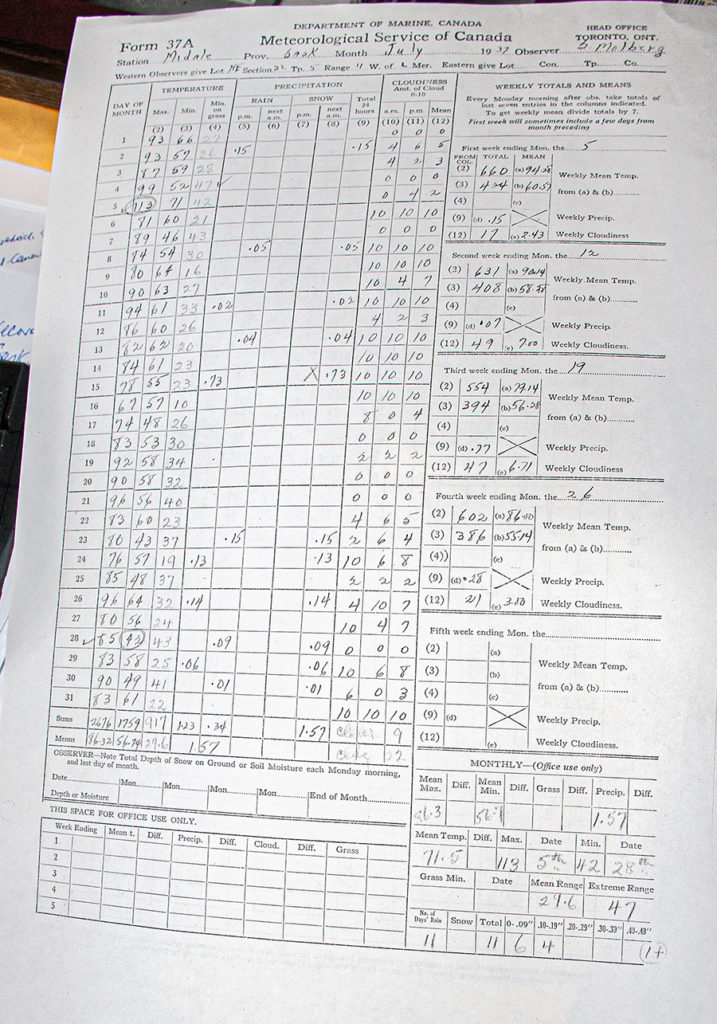
Jean Molberg Brammall, late of Killarney, officially recorded the last highest temperature, 45 degrees C/113 degrees F, back in 1937, in Midale, Saskatchewan
BY KIM LANGEN
For 84 years, the country’s hottest weather record of 113 degrees Fahrenheit held fast and hard, until this past torrid weekend in Lytton, B.C.
And the recording of that previous historical event, which occurred way back in 1937, was carefully entered on the Environment Canada daily data sheet by a 17-year-old Saskatchewan girl.
Charting the temperatures back in the Dirty Thirties was just one of the daily tasks for young Jean Molberg, who was Esther McAuley’s mother.
“It was a job she did every day, and on that day, July 5, 1937, it made history,” said McAuley. “Here’s a national story, but we have a Killarney connection. How fun for us to be part of that history. My kids all emailed me to say that Grandma’s record was broken.”
Jean’s father was Samuel Molberg, born in Sweden, and he was mayor of Midale, and reeve of Cymri Number 36 in Saskatchewan. He was also the municipal secretary for the area, which is why his name is the one historically linked to the weather event in 1937.
But it was McAuley’s mother who actually did the measurements, she said.
“It was recorded in Samuel’s name, because he was responsible for the weather reporting, but it was really my mom’s job, and she did it every day,” said McAuley. “She recorded the temperatures twice a day, at 7 a.m. and 7 p.m., using a Stevenson box, or screen. It was done for Environment Canada, but it was a volunteer thing. Environment Canada has hundreds of volunteers across Canada that do this job.”
A Stevenson screen is a white louvered box, which can be found at every observing site in Canada. They protect the temperature sensors from being influenced by direct or reflected sunlight.
The Stevenson screens are always painted white to better reflect the sun’s rays, while the louvered sides allow outside air to flow around the thermometers.
And it was on July 5, 1937, during the years of the Great Depression and very long droughts, that Jean walked out to do her regular recording duties, and discovered that the temperature had soared to 113 degrees Fahrenheit, or 45 degrees Celsius.
“When she told her father it was 113 degrees Fahrenheit, he came out to check it himself,” said McAuley. “When he sent the data to the government, they came out to ascertain that the equipment was not faulty, and it wasn’t. So the record stood. The same temperature had also been reported that day at Yellow Grass, a town between Weyburn and Regina.”
The years went by, summers grew hot, and winters returned each year across Canada. Jean, the youngest of 11 siblings, went on to become a schoolteacher.
But in 2005, the story of the 17-year-old Saskatchewan girl, who dutifully checked the temperatures every day, returned to the limelight – right here in Killarney.
“CBC television sent a crew out from Toronto,” said McAuley. “They were filming a two-part series, called Extreme Weather. It was about ten major weather events, including Quebec’s ice storm, tornadoes, the flood of the century here, fires – all from different regions in Canada. They came to Killarney to talk to my mom, who was 85 then, and to interview me. And they brought a 1935 outfit, for my daughter Laurie to wear. It was a vintage dress, with white sandals, and she was to impersonate my mother for the filming. They recreated her going out to the Stevenson Box to take the temperature that day.”
Filming was done at Lorne Whitelock’s home, said McAuley, as he operated a volunteer weather station there for Environment Canada at the time.
“He lived on Miller Road, behind Killarney Farm Supply, and he had a Stevenson Box on his acreage,” she said. “He used to do weather recording here. The box has two to four thermometers inside, all horizontal, not upright like we are used to, and some can register the highest temperature, and it will stick, and won’t recede. Other ones register the lowest temperature. They interviewed my mom on film, and they also used my daughter for the filming as well. They even sent me copies of the actual sheet of temperature recording that showed the day the record was broken, written in my mother’s hand. She was very neat.”
Last weekend, a heat dome began to dangerously raise the temperatures throughout B.C., the Yukon, Alberta, and Saskatchewan. The highest temperature, of 46.6 degrees Celsius, was clocked in interior hotspot Lytton, which hit the number on both Sunday and Monday, June 27 and 28.
By Tuesday, forecasters were predicting that Manitoba would soon be encompassed by the spreading super-heated weather system.
But it was those burning Lytton numbers that finally put paid to the Midale record, taken down so many years ago by the young Jean Molberg, who passed away in 2019 in Bayside Personal Care Home, still sharp and coherent until her last days.
“My mother was born in 1920, and she lived to be 98 years old,” said Esther McAuley. “She wasn’t overly interested in the weather. But, she would say things like, ‘What are the five components of a blizzard?’ And ‘The weather is turbulent at equinox and the changing of the seasons.’ She would play the piano during thunderstorms. She wasn’t obsessed with it, but I think she had an enhanced interest in it. As a farmer’s wife, the weather would often dictate our family schedule.”
McAuley said that the historic 1937 event still resonates proudly with the whole family.
“It’s awesome to be connected to this historical fact,” she said. “And I was fascinated by a comment my mother once made: ‘Who would think that something I did so habitually and mechanically and methodically would become so significant?’ The weather observation was something she did day in and day out, faithfully, because it was part of her father’s responsibilities, which he in turn entrusted to her. Lots of days she did it without thinking about it much. Perhaps similarly to how we brush our teeth every day, and don’t think about it. And then, 60 years later, and now 84 years later, we are very fascinated with what happened on that one particular day. I suppose if the job of recording hadn’t been so meticulous and methodically done, the highest temperature in Canada might have gone unnoticed, or unacknowledged, or unrecognized. That entry in the weather journal became a significant marker for other weather stories. We would often see Canada‘s highest temperature, with Samuel Molberg‘s name, appear in science textbooks, math textbooks and calendars. It makes me think that lots of everyday things that we do are important, and may have more significance than we might ever imagine.”
Just hours after this story was written on Wednesday, a devastating wildfire ripped through Lytton, B.C., tragically destroying much of the small town and scattering its residents.

MOM WAS A FAMOUS WEATHER GIRL – Esther MacAuley holds up a photo of her mother, the late Jean Molberg Brammall, who made history back in 1937 when she recorded the record high temperature of 45 C (113 F) in Midale, Saskatchewan, at age 17, as a volunteer with Environment Canada. The record was broken last weekend in Lytton, B.C., when temps soared to 46.6 C. Copies of the meteorological documents were sent in the envelope on right, following a 2005 CBC documentary series, Extreme Weather, that featured Jean and her family.

THE 1937 HEAT RECORD AT MIDALE, SASK. – Above, a copy of the historical Meteorological Service of Canada page on which Jean Moberg, age 17, recorded the country’s record-breaking temperature of 113 degrees Fahrenheit (45 Celsius) on July 5, 1937. “It’s awesome to be connected to this historical fact,” said her daughter, Esther MacAuley.

